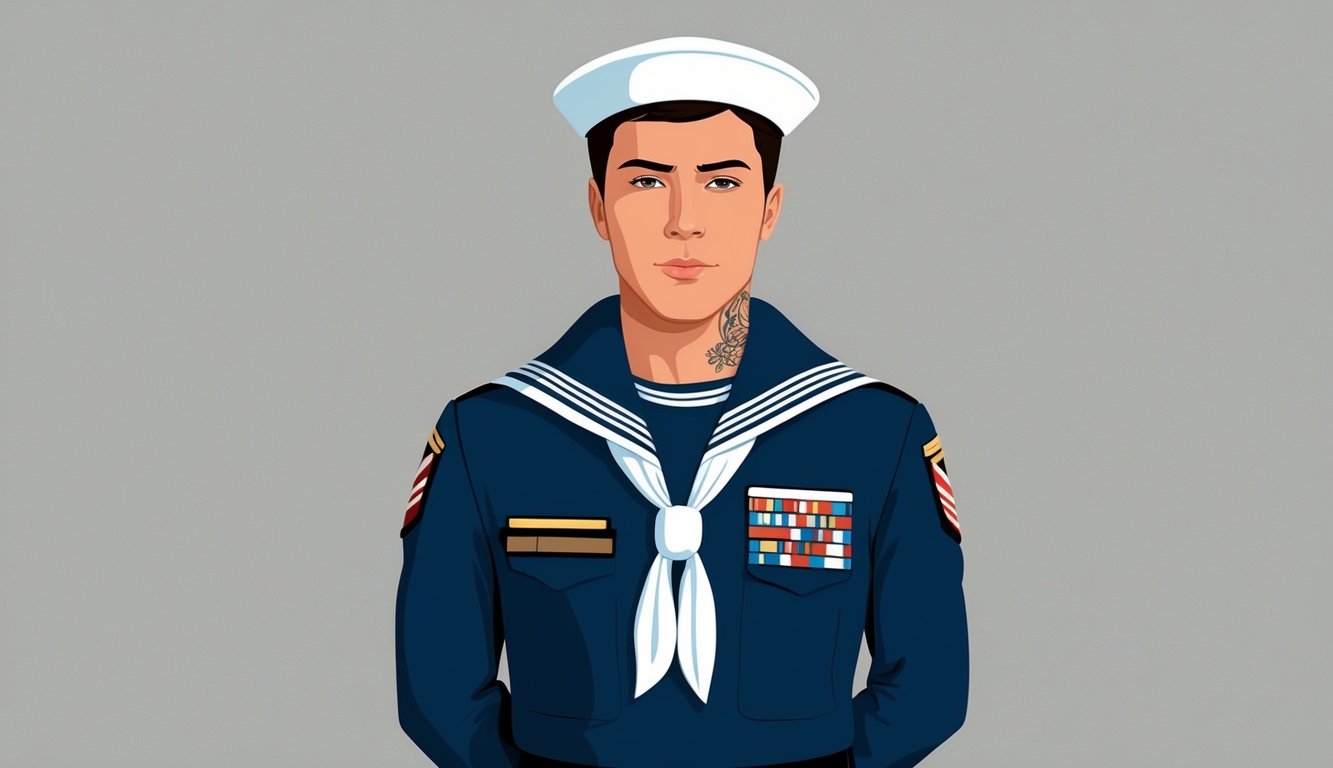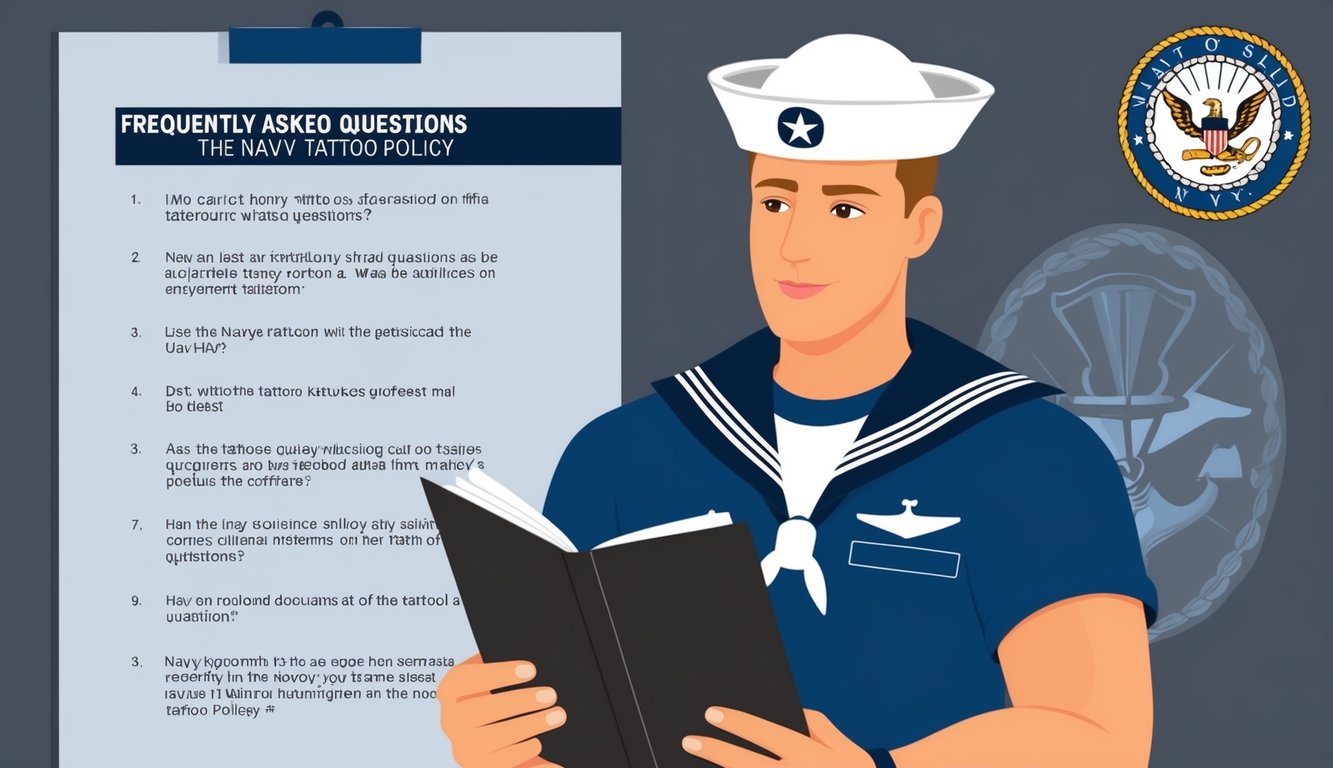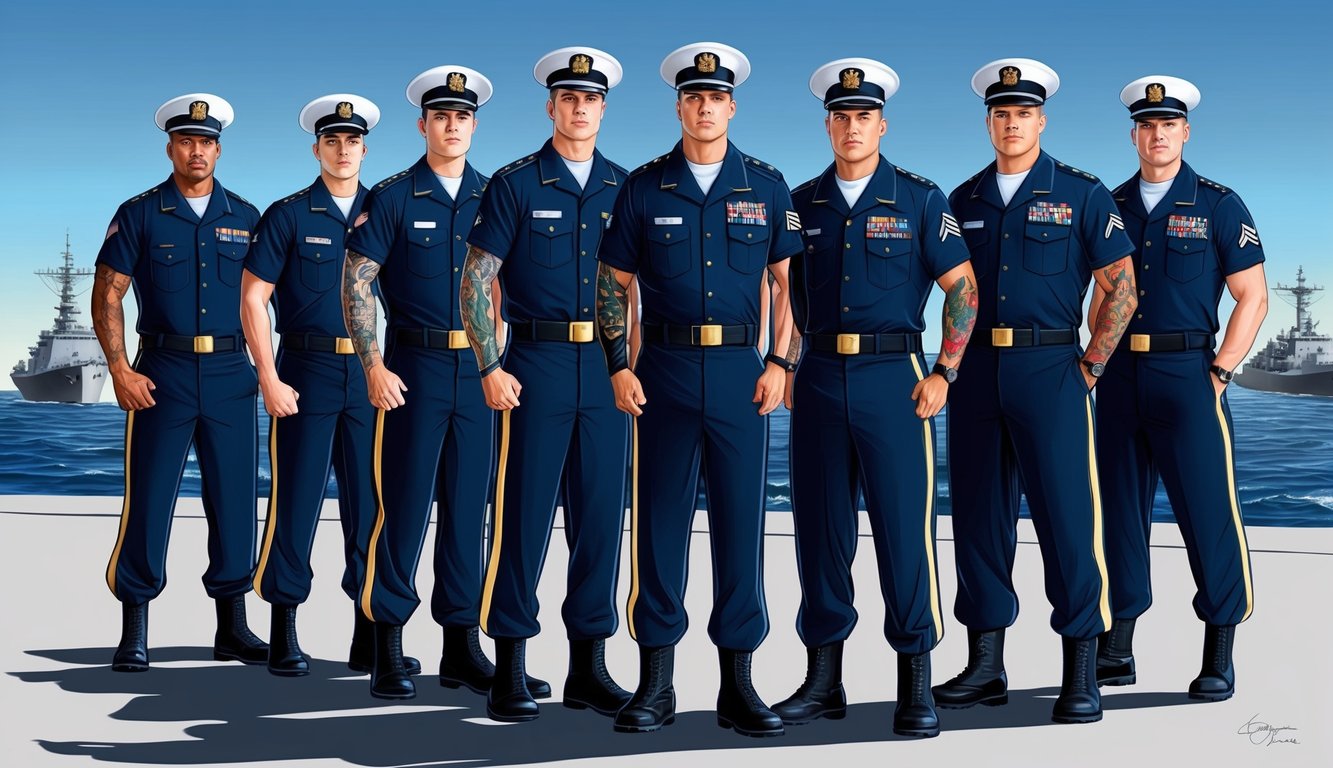Are you considering joining the Navy or currently serving and thinking about getting some new ink? The tattoo policy of the U.S. Navy has undergone significant changes in recent years, mirroring evolving cultural norms and attitudes.
The Navy now permits tattoos in a wider array of locations and sizes than ever before, including full sleeves on arms and legs, as well as small tattoos on the neck.
The strict regulations on tattoo sizes and the outright bans on visible tattoos have mostly disappeared.
You now have greater freedom to showcase your individuality through body art while serving your nation.
However, some limitations are still in place to uphold professionalism and readiness.
If you’re a prospective recruit or an active sailor, understanding the current Navy tattoo policy is essential.
It influences not only your eligibility for joining but also your everyday life in uniform and prospects for career advancement.
Key Takeaways
- Full sleeve tattoos and a small neck tattoo (up to 1 inch in diameter) are now allowed in the Navy
- Tattoos on the head, face, hands, and wrists remain prohibited
- Restrictions on content are in place to ensure tattoos align with Navy values and readiness
Historical Context of Navy Tattoo Policies
The tattoo policies of the U.S. Navy have seen significant changes over time, keeping pace with shifting cultural attitudes and military requirements.
These policies have generally been more flexible compared to those of other military branches.
Evolution Over Time
With deep roots in naval tradition dating back to Captain James Cook’s voyages to Tahiti in 1768, sailors often embraced tattoos as symbols of their journeys.
By the 19th century, tattooing had become a common practice among Navy personnel.
Historically, the Navy placed restrictions on visible tattoos, viewing them as unprofessional.
However, as tattoos gained mainstream acceptance, these policies began to relax.
A significant change occurred in 2016 when the Navy allowed neck tattoos and full sleeves for the first time.
This adjustment was designed to widen recruitment opportunities and reflect contemporary societal values.
You can now enlist in the Navy with more visible tattoos, provided they are not offensive or located on your face.
Comparisons With Other Military Branches
Presently, the Navy has the most tolerant tattoo policy among the U.S. military branches.
While the Army and Air Force have also amended their rules, they still enforce stricter regulations than the Navy.
For instance, the Army restricts hand tattoos to one ring tattoo per hand.
The Air Force forbids tattoos that cover more than 25% of the body.
Conversely, the Navy permits full sleeves and hand tattoos.
In contrast, the Marine Corps enforces a complete ban on sleeve tattoos, emphasizing the Navy’s more progressive approach to body art, distinguishing it from other services.
Understanding the Current Navy Tattoo Policy
The U.S. Navy has made considerable strides in relaxing its tattoo policy, granting sailors increased freedom to express themselves through body art.
These changes are intended to attract and retain skilled personnel while upholding professional standards.
General Guidelines
Navy personnel can now showcase more tattoos.
The policy promotes personal expression while ensuring a professional appearance.
Tattoos should not interfere with uniform wear or the proper fitting of safety equipment.
It’s your responsibility to ensure compliance with the policy.
If you have any doubts about a tattoo, consult your chain of command.
Be aware that visible tattoos could influence your eligibility for certain assignments, particularly those that require public interaction or diplomatic duties.
Tattoo Size and Visibility
The Navy has lifted the restrictions on tattoo sizes for arms and legs.
You’re allowed full sleeve tattoos on both arms and legs, marking a considerable shift from previous policies that imposed coverage limits.
Neck tattoos are allowed but must be smaller than 1 inch in diameter.
Hand tattoos, including ring designs, are also permitted.
This change reflects the growing acceptance of tattoos within society.
Location and Number of Tattoos
Tattoos are permitted on most parts of your body; however, certain areas remain off-limits.
Tattoos are not allowed on your head, face, ears, or scalp to maintain professionalism in uniform.
There’s no cap on the number of tattoos you can have as long as they adhere to size and location guidelines.
This change allows greater personal expression through body art while serving in the Navy.
Content Restrictions
Despite the more lenient stance on tattoo size and placement, content restrictions remain stringent.
Tattoos must not convey any racist, discriminatory, indecent, extremist, or supremacist messages or imagery.
Gang-related tattoos are banned, as is the Confederate flag.
These policies aim to support unity and respect within the Navy.
Your tattoos should not undermine good order, discipline, or morale.
If you’re uncertain about the content of a tattoo, it’s best to consult your chain of command before proceeding.
Specific Tattoo Locations and Regulations
The Navy has established detailed guidelines for tattoos based on their body placement.
These rules are meant to uphold a professional image while permitting some personal expression through body art.
Head, Face, and Neck Guidelines
Tattoos on the head, face, and neck are mostly prohibited in the Navy.
You cannot have visible tattoos above the collar of your uniform shirt while wearing a crew neck tee, including areas behind the ears and the scalp.
Face tattoos are strictly off-limits.
The Navy aims to ensure a professional appearance, especially for roles involving public interaction.
Neck tattoos are also restricted as they can be easily visible in uniform.
Arm and Leg Tattoos
The Navy’s policy has become more accommodating regarding arm and leg tattoos.
Full sleeves that extend from the shoulders to the wrists are now allowed.
Tattoos on the legs are permitted from the top of the knees down to the ankles.
Bear in mind that offensive content is never permitted, regardless of the tattoo’s location.
Tattoos should not be visible through white uniform shirts.
Torso and Body Tattoos
Tattoos on your torso and body are generally acceptable as long as they remain hidden in uniform.
This includes your chest, back, and abdomen.
You should consider how extensive your tattoos are since they may become visible during physical training or swimming.
The Navy may require you to cover large or inappropriate tattoos in certain contexts.
Hand and Finger Tattoos
You may have one hand tattoo per hand, no larger than 1 inch in size.
It must be located between the wrist and the knuckle closest to the wrist.
Finger tattoos are acceptable, allowing one ring-type tattoo per hand.
These tattoos cannot extend beyond the joint nearest to the palm.
Remember, even in these small areas, offensive or inappropriate designs are not allowed.
Cosmetic and Medical Tattoos
The Navy makes exceptions for specific cosmetic and medical tattoos.
These can include permanent makeup like eyeliner or eyebrow tattoos, provided they appear natural and conservative.
Medical tattoos that result from surgical procedures or medical conditions are also permitted.
These need to be documented and performed by qualified medical personnel, as the Navy recognizes their purpose beyond mere personal expression.
Implications for Navy Personnel
The updated tattoo policy significantly impacts sailors’ careers and the culture within the Navy.
It affects recruitment, advancement opportunities, and potential disciplinary measures.
Recruitment Implications
Joining the Navy is now more accessible for individuals with tattoos.
The relaxed policy broadens the pool of potential recruits who may have been disqualified previously.
Recruiting Command can now evaluate a wider array of candidates, particularly those with sleeve or neck tattoos.
This shift aids the Navy in competing for talent in a challenging job market.
You are no longer limited by size restrictions for arm and leg tattoos.
Nonetheless, the content of your tattoos remains relevant as sexually explicit, gang-related, or extremist tattoos are still prohibited.
Career Impact and Advancements
Your existing tattoos are less likely to affect your Navy career at this point.
The new policy offers greater avenues for self-expression while in uniform.
You can ascend the ranks with visible tattoos that were previously barriers to advancement.
Positions in leadership and officer roles are now more attainable for tattooed sailors.
Your qualifications and performance are prioritized over your tattoos.
This adjustment enhances morale and retention among personnel with tattoos.
However, remember that certain roles may still enforce stricter appearance standards, particularly for special duty assignments that require covering visible tattoos.
Disciplinary Actions
If your tattoos violate content guidelines, you may face disciplinary action.
Commanding officers possess the authority to enforce these policies.
Tattoos displaying gang symbols, extremism, or discrimination are strictly forbidden.
Getting a non-compliant tattoo while on active duty may lead to consequences ranging from counseling to potential involuntary discharge in severe instances.
It is vital to understand and adhere to the policy to prevent disciplinary actions.
The Navy seeks to uphold good order and discipline while allowing greater personal freedom.
You are responsible for ensuring that any new tattoos align with regulations.
Cultural and Religious Considerations
The Navy’s tattoo policy acknowledges diverse cultural and religious considerations.
It strives to balance personal expression with military standards while respecting diversity.
Religious Tattoos
Many sailors find religious tattoos to be deeply meaningful.
The Navy generally allows these, provided they adhere to size and placement regulations.
You can have religious symbols or verses inked as long as they remain non-offensive and moderate.
Common religious tattoos could include crosses, Bible verses, or symbols from other faiths.
The Navy honors the significance of religious expression while expecting tattoos to be discreet and not interfere with uniform appearance.
Cultural Significance
Tattoos often possess cultural significance, especially for sailors coming from varied backgrounds.
The Navy embraces this, allowing various culturally significant designs.
For example, Polynesian tribal tattoos are typically permissible since they can represent family heritage or personal accomplishments.
Native American tribal designs also qualify as culturally significant tattoos that are often accepted.
While the Navy is increasingly accommodating of cultural tattoos, it is crucial that they still meet the size and placement criteria.
Respecting Diversity
The tattoo policy aims to respect diversity while upholding a professional image.
You are encouraged to honor your heritage through tattoos as long as they do not advocate discrimination.
Any tattoos that could be interpreted as racist, sexist, or extremist are strictly prohibited.
This approach fosters an inclusive atmosphere for all sailors.
The Navy routinely reviews its policy to ensure it aligns with evolving societal values.
If you’re considering a new tattoo and are uncertain about its acceptability, consulting your chain of command is advised.
Daily Life and Appearance Standards

Navy personnel must adhere to rigorous standards governing uniforms, grooming, and body modifications.
These regulations aim to maintain a professional and unified image across the fleet.
Uniform Regulations
You are expected to wear your uniform with pride and precision.
Navy uniforms come in various types, including service dress, working uniforms, and physical training attire, each with specific wear and care guidelines.
Ensure your uniform is clean, pressed, and fits properly.
Focus on details like the placement of collar devices, ribbons, and insignia.
Shoes should be polished and well-maintained.
When wearing civilian attire on duty or in foreign ports, select conservative clothing that reflects positively on the Navy.
Avoid garments with offensive slogans or overly revealing styles.
Grooming and Presentation
Your hair must always be neat, clean, and well-groomed.
For men, hair should not touch the ears or collar, and sideburns cannot extend below the middle of the ear.
Women are required to secure their hair above the collar while in uniform.
Facial hair is generally not allowed, except for neatly trimmed mustaches that do not extend beyond the corners of the mouth.
Medical waivers may permit limited beard growth.
Maintain clean, trimmed nails.
While women can wear conservative nail polish in uniform, men should refrain from wearing any nail polish.
Good oral hygiene is essential, and avoid visible dental adornments such as gold teeth or non-natural colored dental work.
Body Modification and Adornments
The Navy has specific policies concerning tattoos, piercings, and other body modifications.
While tattoos are permitted, they must comply with content and location restrictions.
They cannot be visible above the neck or below the wrists while in uniform.
Body piercings, apart from small, conservative earrings for women, are not allowed while in uniform.
Ensure all other visible piercings are removed when on duty.
Avoid extreme body modifications such as tongue splitting or excessive ear gauging, as these could be deemed mutilation and affect your eligibility to serve.
Following these standards is crucial for preserving the professional image and traditions of the naval service.
Administration and Enforcement

The administration of the Navy’s tattoo policy depends on leadership at various levels to effectively implement and enforce the regulations.
Commanding officers play a pivotal role, overseeing processes for addressing violations and considering exceptions.
Role of Commanding Officers
Commanding officers (COs) are the chief enforcers of the Navy’s tattoo policy.
They possess the authority to interpret and implement the rules within their units.
COs evaluate whether tattoos comply with size, content, and placement regulations.
Consultation with the Chief of Naval Personnel may occur for clarity on complex matters.
The Master Chief Petty Officer of the Navy often provides input on policy application throughout the fleet.
COs are tasked with educating sailors about the policy and ensuring compliance during inspections and day-to-day operations.
Processing Violations
If you breach the tattoo policy, your CO will typically initiate disciplinary measures.
This may include counseling, administrative remarks in your service record, or more serious repercussions for repeated violations.
The process typically begins with a verbal warning.
If issues persist, you may receive written counseling or a Page 13 entry.
Serious or repeated violations could lead to administrative separation proceedings.
Your chain of command will document all actions taken to address policy breaches, ensuring fair treatment and providing a record for any future implications.
Seeking Exceptions and Waivers
Under certain circumstances, you may request exceptions to the tattoo policy.
Initiate discussions with your immediate supervisor about your situation to receive guidance on the appropriate waiver submission process.
Waivers generally require robust justification and undergo multiple levels of review.
The Chief of Naval Personnel holds final approval authority for most exceptions.
Common motivations for seeking waivers could include pre-existing tattoos acquired pre-enlistment or tattoos of cultural/religious significance.
Be prepared to submit detailed documentation to support your request.
Frequently Asked Questions

The tattoo policy in the Navy has transformed to be more inclusive while maintaining professional standards.
Here are some common questions regarding current regulations.
Can you have tattoos on your hands while serving in the Navy?
Yes, you are permitted to have tattoos on your hands while serving in the Navy.
The policy allows for hand tattoos, including on the fingers and palms.
There are no size restrictions for hand tattoos.
What changes were made to the Navy tattoo policy in 2024?
In 2024, the Navy further relaxed its tattoo policy.
You can now sport larger and more visible tattoos on your arms and legs.
The size limitations for these areas have been eliminated, permitting full sleeves.
Are neck tattoos permitted for Navy personnel?
Yes, neck tattoos are permitted for Navy personnel now.
You can have one neck tattoo, but it must not exceed one inch in any direction.
This adjustment reflects the Navy’s keen awareness of current trends.
What are the regulations for officer tattoos in the Navy?
For officers, tattoo regulations in the Navy generally mirror those for enlisted personnel.
You can have visible tattoos on your arms, legs, hands, and neck.
The same size and content rules apply to both officers and enlisted members.
How does the Navy’s tattoo policy compare with the Marine Corps?
The Navy’s tattoo policy is significantly more flexible than that of the Marine Corps.
You enjoy greater freedom in the Navy regarding tattoo size and placement.
The Marine Corps, however, still enforces stricter regulations, especially concerning visible tattoos while in uniform.
Does the Navy provide assistance with tattoo removal?
The Navy does not usually provide or cover the cost of tattoo removal as a standard service.
If you possess a tattoo that is non-compliant with the policy, you may have to remove it at your own expense.
In certain situations, waivers may be available for existing tattoos.

